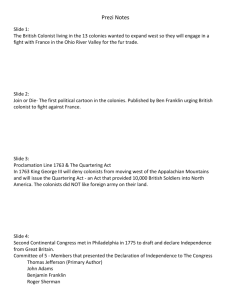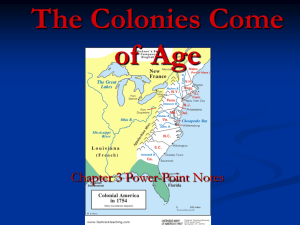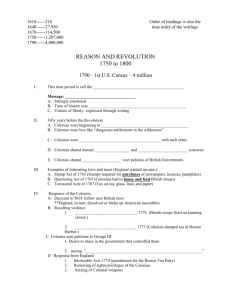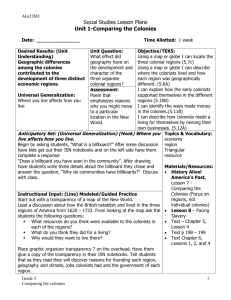Prezi Notes
advertisement
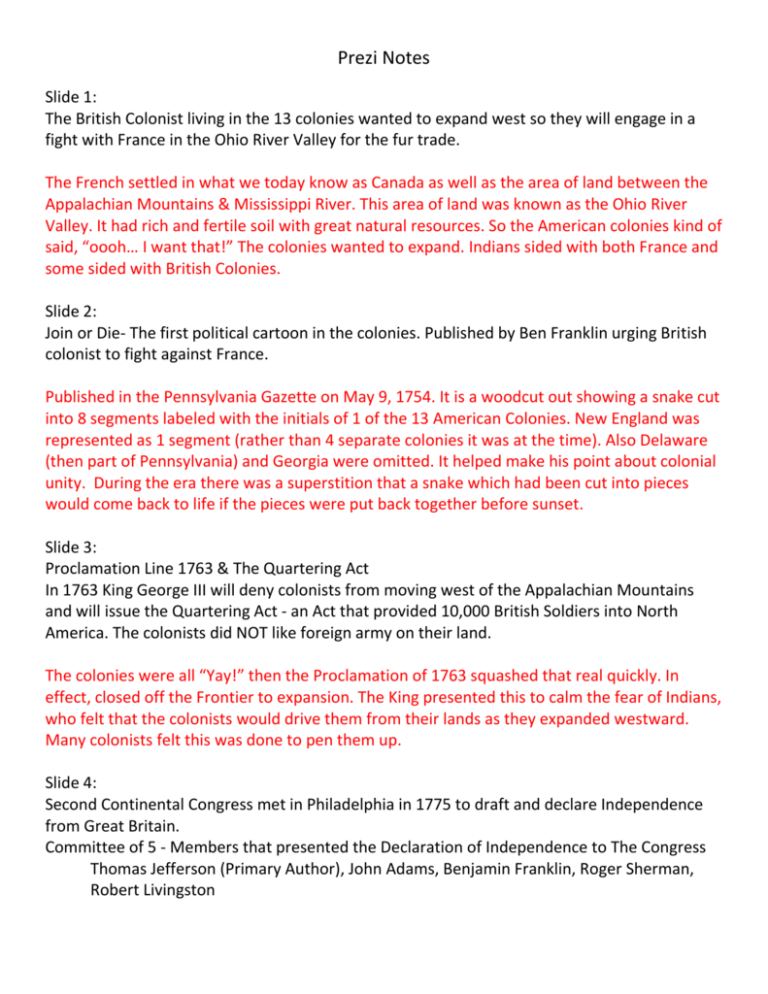
Prezi Notes Slide 1: The British Colonist living in the 13 colonies wanted to expand west so they will engage in a fight with France in the Ohio River Valley for the fur trade. The French settled in what we today know as Canada as well as the area of land between the Appalachian Mountains & Mississippi River. This area of land was known as the Ohio River Valley. It had rich and fertile soil with great natural resources. So the American colonies kind of said, “oooh… I want that!” The colonies wanted to expand. Indians sided with both France and some sided with British Colonies. Slide 2: Join or Die- The first political cartoon in the colonies. Published by Ben Franklin urging British colonist to fight against France. Published in the Pennsylvania Gazette on May 9, 1754. It is a woodcut out showing a snake cut into 8 segments labeled with the initials of 1 of the 13 American Colonies. New England was represented as 1 segment (rather than 4 separate colonies it was at the time). Also Delaware (then part of Pennsylvania) and Georgia were omitted. It helped make his point about colonial unity. During the era there was a superstition that a snake which had been cut into pieces would come back to life if the pieces were put back together before sunset. Slide 3: Proclamation Line 1763 & The Quartering Act In 1763 King George III will deny colonists from moving west of the Appalachian Mountains and will issue the Quartering Act - an Act that provided 10,000 British Soldiers into North America. The colonists did NOT like foreign army on their land. The colonies were all “Yay!” then the Proclamation of 1763 squashed that real quickly. In effect, closed off the Frontier to expansion. The King presented this to calm the fear of Indians, who felt that the colonists would drive them from their lands as they expanded westward. Many colonists felt this was done to pen them up. Slide 4: Second Continental Congress met in Philadelphia in 1775 to draft and declare Independence from Great Britain. Committee of 5 - Members that presented the Declaration of Independence to The Congress Thomas Jefferson (Primary Author), John Adams, Benjamin Franklin, Roger Sherman, Robert Livingston Slide 5: Declaration of Independence: Thomas Jefferson was the primary author. It was signed on July 4, 1776. It was greatly influence by John Lock who was a British Enlightenment Figure. Unalienable Rights: Life, Liberty and the Pursuit of Happiness Slide 6: IN CONGRESS, July 4, 1776. / The unanimous Declaration of the thirteen united States of America, When in the Course of human events, it becomes necessary for one people to dissolve the political bands which have connected them with another, and to assume among the powers of the earth, the separate and equal station to which the Laws of Nature and of Nature's God entitle them, a decent respect to the opinions of mankind requires that they should declare the causes which impel them to the separation. We hold these truths to be self-evident, that all men are created equal, that they are endowed by their Creator with certain unalienable Rights, that among these are Life, Liberty and the pursuit of Happiness.–That to secure these rights, Governments are instituted among Men, deriving their just powers from the consent of the governed, –That whenever any Form of Government becomes destructive of these ends, it is the Right of the People to alter or to abolish it, and to institute new Government, laying its foundation on such principles and organizing its powers in such form, as to them shall seem most likely to effect their Safety and Happiness. Slide 7: American Revolution (1775 - 1783) Lexington & Concord begins the war - Shot heard around the world. Saratoga- Turning point War ends at Yorktown Treaty of Paris (1783) will officially give the United States Independence from Great Britain. Slide 8: The Results: Articles of Confederation & the Constitution of the United States. The Articles of Confederation 1787 - Constitutional Convention U.S. Constitution Bill of Rights Preamble Principles of the Constitution Federalist / Anti-Federalist Argument
